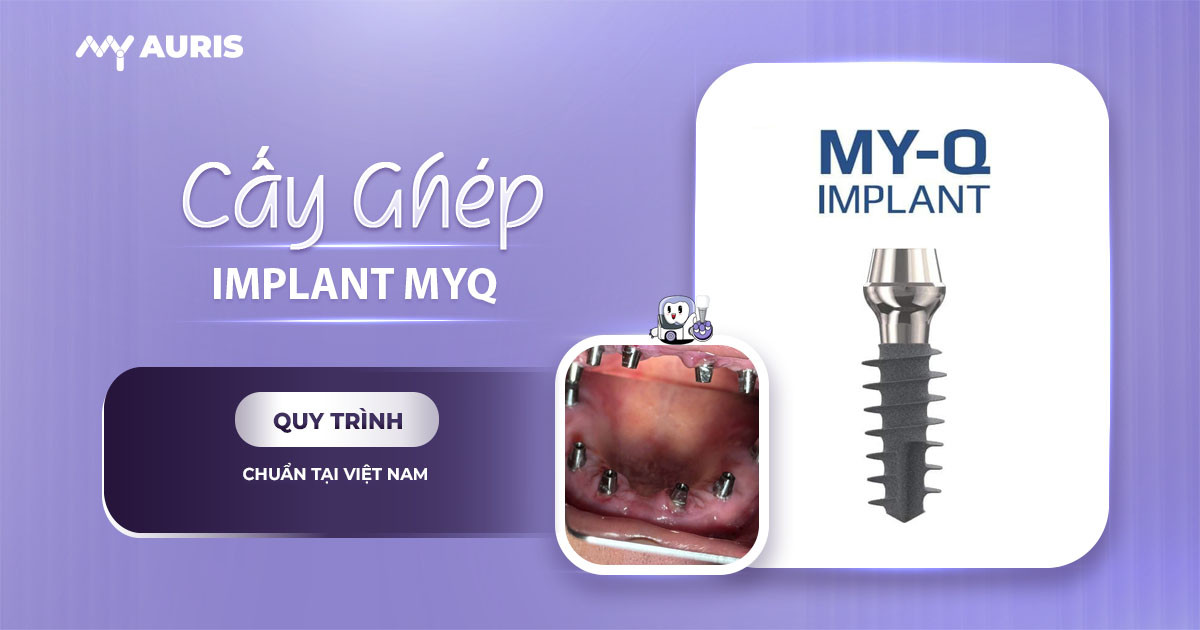Tooth loss affects chewing function and aesthetics. Dental implant placement is a solution for restoring lost teeth, helping to restore a structure almost like natural teeth. Among these, the MYQ implant post is an option that has received attention. This article by My Auris provides objective and essential information about this implant line to help you make an informed decision.
Is the MYQ implant post good?
Is the MYQ implant post good? This is a core question many tooth loss patients are concerned about when seeking an effective tooth restoration solution. The answer depends on an evaluation across many aspects, from technical and biological to economic. In reality, MYQ implant is a dental implant system originating from South Korea, manufactured with the goal of providing high effectiveness and reasonable cost.
Let’s analyze the detailed technical characteristics of the MYQ implant for a comprehensive answer:
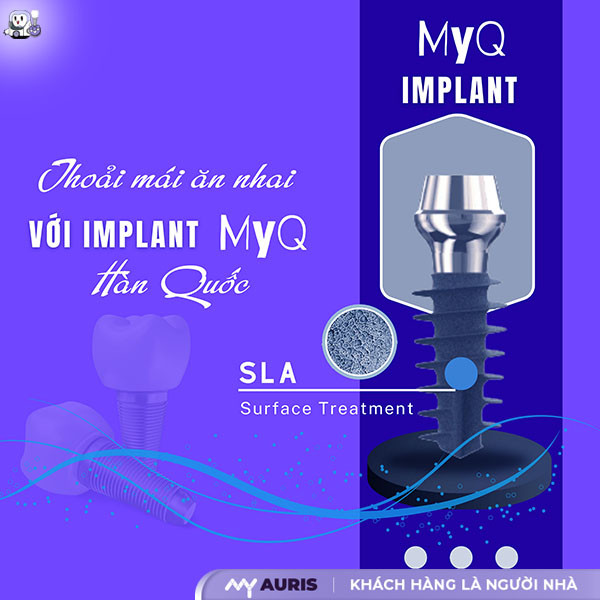
Pure Titanium Material and High Biocompatibility
The foundation of all dental implants is the material. MYQ implant uses Medical-Grade Pure Titanium. This is a biomaterial that has been proven over decades in medicine.
Body-safe: Titanium does not cause rejection or allergic reactions. When implanted into the jawbone, the human body accepts it as a natural part. This material does not interact with blood or surrounding soft tissues like gums.
Facilitates Osseointegration: The biocompatibility of Titanium is a prerequisite for the osseointegration process. Bone cells can grow and attach directly to the implant post’s surface, creating a strong bond. This bond forms the foundation for the entire dental restoration structure, from the implant post and abutment to the crown.
Mechanical Strength: Titanium is lightweight yet very rigid, strong enough to withstand significant pressure from daily chewing without deforming or breaking. This ensures the implant’s lifespan can be extended, even permanently, if properly cared for.
Breakthrough SLA Surface Treatment Technology
The surface of the implant post is a decisive factor in the speed and quality of osseointegration. MYQ implant applies a unique and advanced surface treatment technology, commonly known as SLA (Sand-blasted, Large-grit, Acid-etched).
Mechanism of Action: The implant post’s surface is micro-roughened through sand-blasting and acid-etching. This process creates countless tiny cavities on the surface.
Direct Benefits for Tooth Loss Patients: These micro-cavities increase the contact area between the implant post and the jawbone. They act as anchor points, encouraging bone cells to migrate, attach, and grow faster. This process leads to extremely short osseointegration times, reducing the total treatment duration for patients.
High Success Rate: Thanks to good initial stability and accelerated healing, SLA technology contributes to an exceptionally high success rate for MYQ implant procedures. It is particularly effective for cases requiring rapid tooth restoration or when bone quality is not ideal.
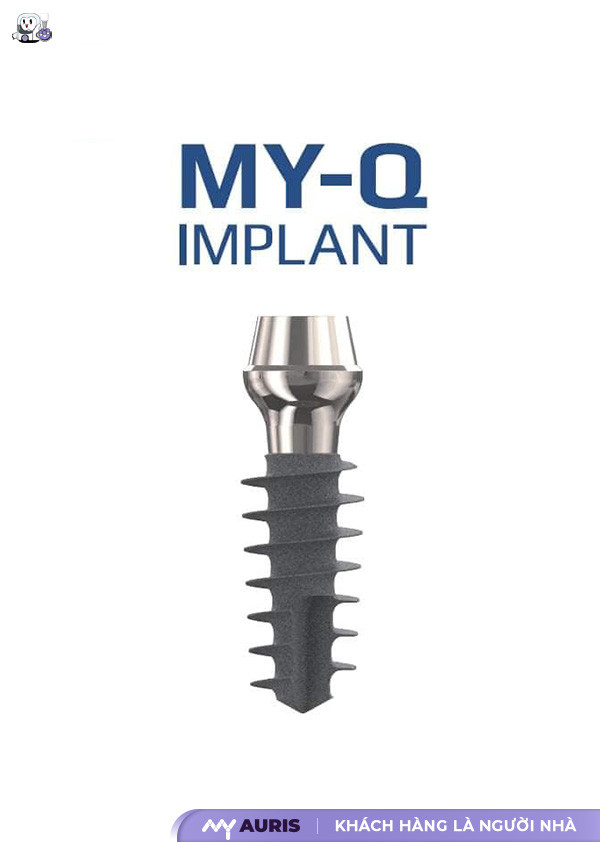
Optimized Thread Design and Durable Load-Bearing Capacity
The design of the MYQ implant post is not arbitrary. Every detail is calculated to optimize implant effectiveness.
Characteristic Thread Design: MYQ implant features a characteristic thread and shape design, allowing the implant post to easily advance into the jawbone during the surgical placement process. These threads help increase initial stability immediately after placement, a crucial factor in preventing micro-movement and facilitating bone healing.
Even Force Distribution: This design helps distribute chewing forces evenly throughout the jawbone, avoiding the creation of excessive pressure points that could lead to bone loss. This ensures optimal load-bearing capacity, allowing you to chew comfortably, almost like with natural teeth.
Bone Structure Protection: Proper force distribution helps preserve the jawbone around the implant, maintaining the long-term stability of both the dental restoration structure and gum aesthetics.
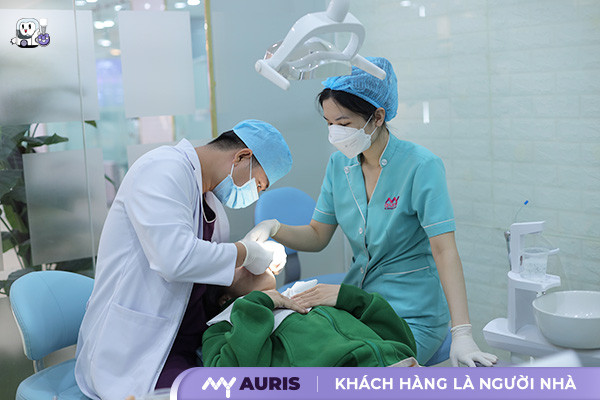
MYQ Implant Placement Procedure in Vietnam
Step 1: Clinical Examination and Consultation
The dentist conducts a comprehensive examination of the oral health. They assess jawbone density, the location of missing teeth, and factors related to bone structure, gums, nerves, and blood circulation in the implant area. Patients undergo X-ray and Cone Beam CT scans to develop a suitable treatment plan.
Step 2: Personalized Treatment Planning
Based on clinical data, the doctor establishes a specific treatment protocol, selecting the appropriate MYQ implant post size. MYQ implant stands out due to its deep thread design and special surface treatment, ensuring rapid osseointegration and high load-bearing capacity. This helps increase the success rate in permanent tooth restoration.
Step 3: Implant Placement Surgery
The surgery is performed under strict sterile conditions. The dentist creates an osteotomy in the jawbone and places the medical-grade pure Titanium MYQ post in the predetermined position. This procedure requires high precision to avoid damaging nerves, soft tissues, and blood vessels. If the technique is not standard, complications such as peri-implantitis, loose implant, or rejection may occur.
Step 4: Osseointegration Waiting Period
After post placement, patients need to wait 6–12 weeks for the MYQ implant to fully integrate with the jawbone. During this period, no direct chewing force should be applied to the post. MYQ is rated to have a shorter integration time thanks to its unique surface treatment technology and optimized design for bone tissue.
Step 5: Abutment and Crown Placement
Once the implant is stable, the dentist attaches the abutment and takes impressions to fabricate the porcelain crown. Porcelain restorations offer high aesthetics, biocompatibility, and long lifespan. Patients can chew almost like with natural teeth.
Step 6: Post-Treatment Care Instructions and Regular Check-ups
After the implant procedure is complete, patients receive instructions on proper oral care to prevent gum inflammation and implant loosening. The clinic schedules regular follow-up appointments to monitor osseointegration and make adjustments if necessary.
Comparing MYQ Implants with Other Implant Types
Below is a practical analysis to help readers evaluate and make an informed choice:
Detailed Comparison Table of MYQ Implants and Other Common Implant Types
| Comparison Criteria | MYQ Implant | Other Implant Types (Common/Budget-friendly) |
Material & Biocompatibility |
Uses medical-grade pure Titanium, enhancing biocompatibility and reducing gum inflammation.
With good osseointegration, chewing function will be restored stably and durably. |
Often uses mixed alloys or non-standard Titanium, which may cause biological reactions, rejection, or allergies. |
Surface Design & Osseointegration |
Special surface treatment technology results in extremely short osseointegration times (only 6–8 weeks), shortening the treatment process.
The successful osseointegration rate is reported to be very high (over 98%). |
Osseointegration time is longer, typically 3–6 months, requiring patients to wait longer. |
Abutment System & Flexibility |
Wide-compatible abutment system, suitable for various crown types (zirconia, porcelain-fused-to-metal…).
Flexible design facilitates easier handling by dentists and enhances restoration effectiveness. |
Some have fixed abutments, limiting crown choices and causing difficulties when adjustments or replacements are needed. |
Aesthetics & Functional Restoration |
Design helps maintain a natural gum line, ensuring proper occlusion and high aesthetics.
An effective restoration solution for both form and function. |
Can easily cause gum recession, exposing the crown margin, reducing aesthetics, and potentially causing a bulky, uncomfortable feeling. |
Durability & Warranty |
Lifetime warranty (when placed at a qualified dental clinic).
Lifespan can extend for decades if properly cared for. |
Shorter warranty period, typically only 5–10 years. |
Cost & Economic Efficiency |
Medium – high cost, commensurate with superior quality, technology, and durability, providing long-term effectiveness. | Lower cost but often comes with a higher risk of complications, potentially incurring additional corrective costs later. |
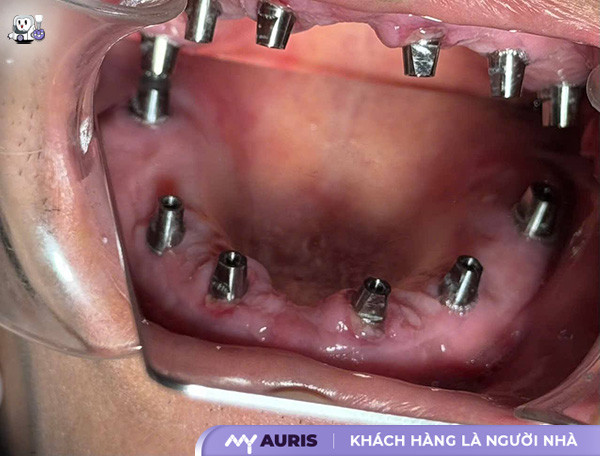
How much does MYQ implant placement cost?
At standard dental clinics, the price for MYQ implant placement ranges from 14,000,000 to 20,000,000 VND per implant post, not including the crown. The price may vary depending on:
Implant post material: MYQ uses medical-grade pure Titanium, with an exclusive thread design and biocompatible surface treatment to accelerate osseointegration and reduce complications.
Restoration technique: Standard medical implant surgery method, combined with precise porcelain restoration, helps restore stable chewing function, high aesthetics, and a long implant lifespan.
Dentist’s experience: Dentists specializing in dental implants, with thorough understanding of jawbone, gums, and nerve structures, help reduce risks during and after surgery.
Accompanying technology: Some clinics use 3D scanning technology and digital implant placement devices, increasing accuracy and shortening treatment time.
To give you a clearer picture, the reference price list below applies to common cases:
| Item | Estimated Price (VND) |
| MYQ Implant Post | 14,000,000 – 20,000,000 |
| All-porcelain Crown | 2,000,000 – 5,000,000 |
| Healing Cap and Abutment (connector) | Included with MYQ implant post |
| Total cost for 1 MYQ implant tooth | 16,000,000 – 25,000,000 |
Oral Care After MYQ Implant Placement
Phase 1: First 24 to 48 hours after surgery (Bleeding control and swelling reduction phase)
This is the most critical time. The human body begins to react to implant surgery. The main goals are to control bleeding, reduce swelling, and manage pain.
Bite on gauze: Hold a sterile gauze pad firmly over the implant site for about 30-60 minutes after leaving the dental clinic. Gentle pressure helps the blood clot quickly. If bleeding persists, replace with a new, clean gauze pad and continue biting down.
Apply cold compress: Use an ice pack or cold towel on the outside of your cheek, corresponding to the implant site. Apply for 15 minutes, then rest for 15 minutes. Repeat continuously throughout the first day to reduce swelling and constrict blood vessels.
Medication: Take medication exactly as prescribed by your dentist. Do not stop or change the dosage on your own.
Diet: Only consume liquid, cool foods such as porridge, soup, milk. Completely avoid hot, hard, chewy, or spicy foods to prevent irritating the wound.
Rest: Limit strenuous activities, do not bend your head down low, or blow your nose forcefully to avoid increasing pressure on the sinus area and surgical site.
Phase 2: 3 days to 2 weeks (Surface healing phase)
At this point, the gums begin their self-healing process. Maintaining good oral hygiene is the top priority to prevent infection.
Oral hygiene: Begin gently rinsing your mouth with a specialized mouthwash or warm saline solution after each meal and before bedtime. Do not rinse vigorously.
Brushing: Use a super-soft bristle toothbrush. Clean other teeth thoroughly, completely avoiding the implant area. You may use a cotton swab soaked in saline solution to gently clean around the healing abutment if instructed by your dentist.
Diet: Transition to soft foods such as soft rice, vermicelli, pho, steamed fish, well-cooked vegetables. Continue chewing on the non-surgical side of your mouth.
Avoid bad habits: Absolutely no smoking. Nicotine and other toxins constrict blood vessels, reduce oxygen supply to the healing area, and severely hinder the osseointegration process of the Titanium post. Limit alcohol consumption.
Phase 3: After 2 weeks until crown placement (Osseointegration phase)
This is a quiet but crucial phase. The MYQ implant post, made from pure Titanium material and featuring a characteristic surface design, begins the process of biological integration into the jawbone. Even without pain, you still need to maintain a careful care regimen.
Advanced hygiene: You can start brushing your teeth more normally, but still use a soft brush. Pay special attention to cleaning the implant neck area and nearby interdental spaces. Use assistive tools such as a water flosser on the gentlest setting or specialized dental floss for implants to remove plaque. Maintaining healthy gums around the implant post is a key factor for long-term durability. If the MYQ implant placement procedure is not standard, peri-implant infection complications due to poor hygiene may occur.
Nutrition: Supplement with foods rich in calcium, vitamins D, and C to support bone regeneration and integration. You can eat a more varied diet but still avoid hard nuts, bones, chewy candies, overly hot or cold foods. Strong pressure on the implant post during this phase can cause it to shift and fail.
Monitoring: Self-examine the gum area around the implant daily. Healthy gums are pale pink and firm. Any signs of redness, swelling, or pus should be reported to your dentist immediately.
After the crown is fully placed
Brush your teeth twice a day. Use dental floss or a water flosser to thoroughly clean between teeth and the area where the crown meets the gum. Schedule check-ups every 6 months. The dentist will check the osseointegration status via X-ray, the fit of the abutment, perform professional scaling, and assess the overall health of the implant. Avoid using the implant tooth to bite or tear hard objects such as opening bottle caps, biting crab claws, or chewing ice.


